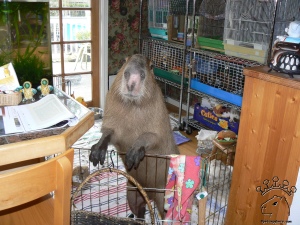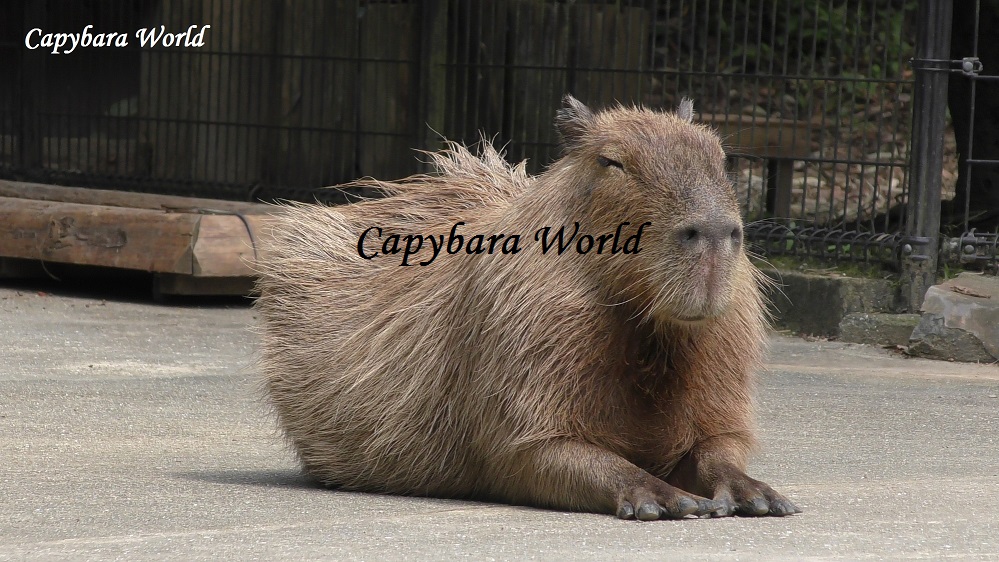
Capybaras have expensive taste.
When people discover capybaras, their reactions are typically either curiosity or aversion. Among the curious, some consider the idea of owning a pet capybara, which naturally leads to questions about its cost. The price of the animal itself is merely a starting point, as anyone who has acquired a “Free Puppy” can attest. So, what is the actual expense of owning a capybara? Surprisingly, they cost about the same as a purebred dog, albeit one from a non-luxurious lineage. Keep in mind, though, that the cost is just the beginning. Let’s start by looking at the steps involved in acquiring one.

On the way home from Texas, 3 weeks old, with his airline-approved carrier.
Only a handful of capybara breeders exist in the U.S., and they maintain just a few breeding pairs. I spent over a year on multiple waiting lists before Hibbye became available. If you have your capybara shipped, it will travel as cargo, adding shipping costs on top of the purchase price. Some breeders do not offer shipping, and even those who do may avoid it in unfavorable weather, so you might need to travel to get your capybara. Airlines generally do not allow rodents in the cabin, meaning even a 3-week-old capybara, similar in size to a guinea pig, must travel in the plane’s cargo hold. When I picked up Hibbye, he was perfectly healthy, but after our trip home in cold weather, he nearly died of pneumonia two weeks later. He had spent a prolonged period on the tarmac in freezing conditions while I urged the baggage handlers to expedite his arrival. Given the chance, I would choose to fly to the breeder, rent a car, and drive him back. At that young age, they are small, quiet, and manageable, and hotels are unlikely to notice a pet. Keep in mind the additional costs of flight, car rental, lodging, and meals for two unless you decide to travel alone.

Plan on at least an initial well-pet checkup, and a neutering. If those are your only veterinary clinic visits, it will be a miracle!
To start, take your baby capybara for a vet checkup. You’ll want your vet to be charmed by this adorable little creature so they won’t be intimidated when you return six months later for neutering with your now larger, slightly wild pet. At a minimum, those two vet visits are necessary. It’s also wise to interview multiple veterinarians beforehand to ensure that one is willing to treat your capybara.

Hibbye’s night pen and boudoir. His bed area gets enclosed for winter.
Around five months of age, my capybara, Hibbye, showed a clear preference for living outdoors. Similar to certain guinea pigs, he started urinating in his bedding while sleeping. If you have a solution for that, I’d love to hear it. Meanwhile, I constructed an outdoor pen with a secure sleeping area. His bed is equipped with multiple blankets and a heavy-duty kennel heater. Additionally, I installed a supplemental microtherm heater on the wall for winter use. He enjoys both paved and dirt areas, hay racks, water, and many toys. His pen is locked securely at night, with two gates that an intruder must pass before reaching his sleeping area. I certainly don’t want a burglar to surprise Hibbye at night. Consider the costs of yard fencing, double gates, and a robust, tall fenced pen, at least 6 feet high, as they can climb over a 4-foot fence. I also wired a top over Hibbye’s pen to keep raccoons out.

You’re joking, right? Young capybaras are obedient and even Hibbye stayed behind this x-pen. Needless to say, he would barge right past this little fence, now!
Capybaras, much like house rabbits, gnaw on wires and cords, making it essential to rodent-proof your home. You’ll likely need various dog/baby gates to keep him within view. You’ll also need to prepare your bathroom with a small potty bowl, which you’ll be emptying up to five times a day. Ideally, dedicate a bathroom to your pet to avoid surprising guests. While most capybaras are relatively clean, accidents happen. These days, Hibbye takes care of his business outside, and as an herbivore, he produces waste in large quantities. I constructed an outdoor bathroom to manage his daily gallon of poop. Consider the costs of modifying a spare bathroom for your capybara.

No capybara in the world has a finer throne room than me.
Wild capybaras graze continuously, day and night. Do you possess sufficient grass, and is it of quality suitable for consumption? Ensure it is free from fertilizers, pesticides, and herbicides. I lack an adequate supply of grass in the backyard, so each afternoon I guide Hibby to the front yard for grazing. Supervision is necessary because the fence is only 4′ high and lacks a double gate, requiring vigilance for unexpected visitors like the postman. The toxic plants such as Rhododendrons, Azaleas, and Pieris have been fenced off to protect him. In winter, when grass is scarce, the cut bamboo foliage must be rationed until spring. Consider revamping your landscape.

No pesticides, no herbicides, no mowing. Your lawn is a food crop.
While I have discussed hay, grass, and bamboo foliage, they represent only a small portion of a capybara’s diet. Supplementation is essential for any captive animal. Just as you wouldn’t expect your cat to hunt for all her food, a capybara requires more than just grass. Young capybaras need milk, preferably goat’s milk. Their diet closely resembles that of a guinea pig, needing plenty of hay and grass. They should also receive a low-protein pelleted food (Hibbye gets Equine Senior), along with vegetables, lettuce, and fruits. Hibbye consumes 3-4 corn cobs daily, including the husks and cob. Procuring corn in January is challenging, hence we order in bulk. He also eats a head of romaine each day. His diet includes pears, apples, and a variety of potatoes, yams, and sweet potatoes. I wish he would resume eating carrots and broccoli, but he prefers oats. As expected, Hibbye has his own refrigerator!

The potato bowl: russets, Yukon Gold, little Irish red, yuppy purple potatoes, sweet potatoes, orange yams, purple yams, and Japanese yams.
Hibbye chews his bed blankets, and those that survive require constant cleaning. I visit Goodwill OUTLET quarterly for new blankets, and we are on our second washing machine. He has his harness, leash, and a ramp to get into the car. The ramp primarily aids him in descending without injuring his chin, as steps are problematic for him. I line the car with blankets and bedding, though he has still managed to bite a chunk out of the car door. The seat belts are his next target. Sacrificing the car’s interior is inevitable, and once hay is loaded in a car, it is impossible to remove completely. Duct tape is our solution for unsightly damage.

A full-grown capybara can easily reach your kitchen counters. Note the sturdy gate he is leaning on.
Planning to travel or visit relatives? Finding a pet sitter is a challenge. Hibbye dislikes strangers, which complicates the situation. Even if you manage to set up a safe environment for both capybara and sitter, you will likely incur significant daily costs. The pet sitter needs to visit multiple times a day to clean the potty bowl, adding to the overall expense of your trip. If the sitter finds the task too overwhelming, be ready to cut your trip short.

Don’t get me started on swimming pools. I think this was pool #2. We’re now up to #6.
A capybara as a pet is far from a simple, extravagant replacement for a dog. The survival rate among first-time, non-zoo owners is discouraging. I’ve been fortunate with Hibbye, largely thanks to excellent veterinary support, willing sitters, and advice from breeders and experienced owners. My family, whether they like it or not, is also involved. While my grown children can opt-out, my partner stands as Hibbye’s main rival, leading to intriguing dramas. Compromise is not in Hibbye’s nature. The real cost of owning a capybara includes not just financial aspects but significant time and lifestyle adjustments. It’s not just about the finances, is it?
* The ROUS Foundation has a veterinarian who can provide guidance to your vet when treatment is needed.



